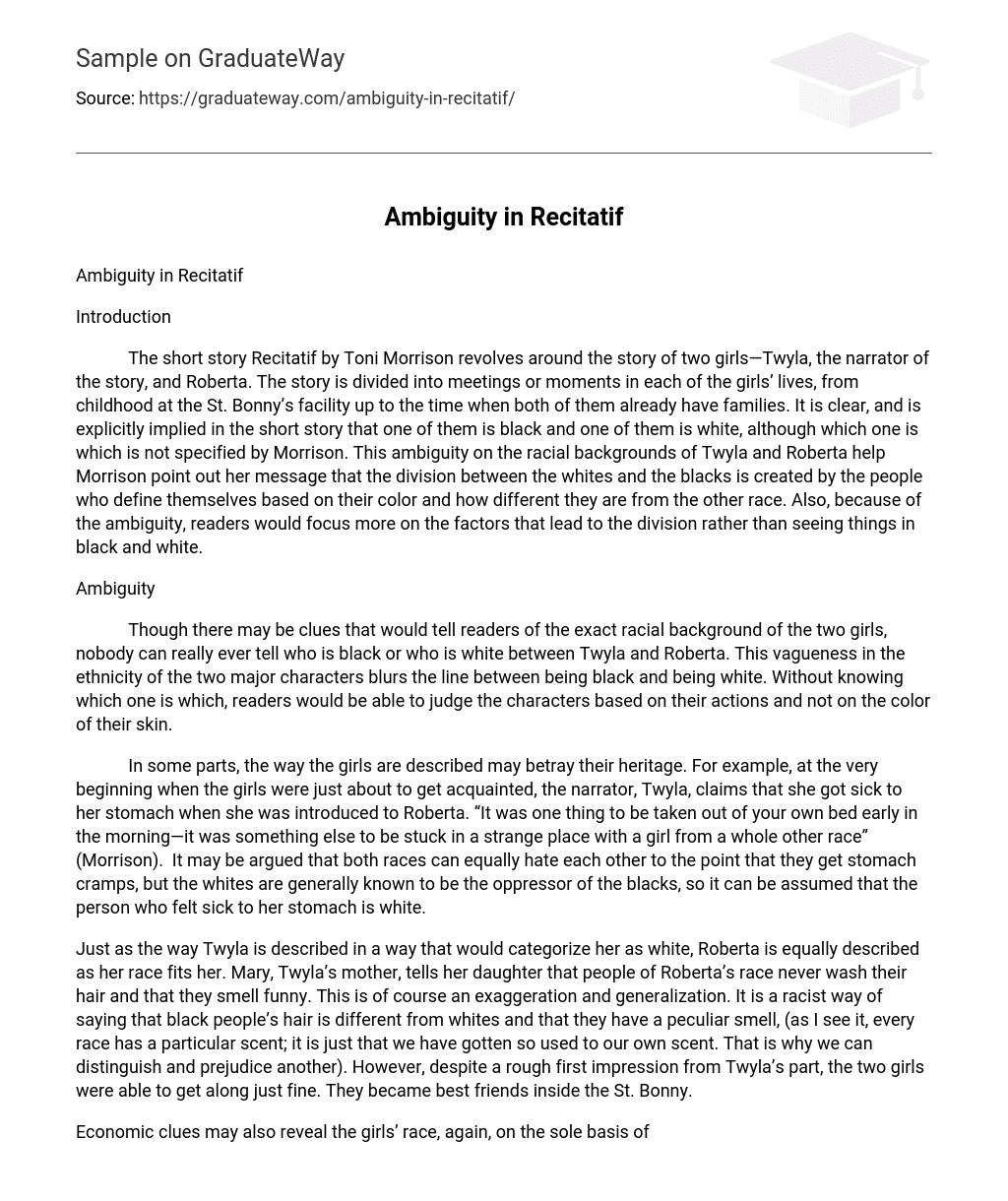Introduction
The short story Recitatif by Toni Morrison revolves around the story of two girls—Twyla, the narrator of the story, and Roberta. The story is divided into meetings or moments in each of the girls’ lives, from childhood at the St. Bonny’s facility up to the time when both of them already have families. It is clear, and is explicitly implied in the short story that one of them is black and one of them is white, although which one is which is not specified by Morrison. This ambiguity on the racial backgrounds of Twyla and Roberta help Morrison point out her message that the division between the whites and the blacks is created by the people who define themselves based on their color and how different they are from the other race. Also, because of the ambiguity, readers would focus more on the factors that lead to the division rather than seeing things in black and white.
Ambiguity
Though there may be clues that would tell readers of the exact racial background of the two girls, nobody can really ever tell who is black or who is white between Twyla and Roberta. This vagueness in the ethnicity of the two major characters blurs the line between being black and being white. Without knowing which one is which, readers would be able to judge the characters based on their actions and not on the color of their skin.
In some parts, the way the girls are described may betray their heritage. For example, at the very beginning when the girls were just about to get acquainted, the narrator, Twyla, claims that she got sick to her stomach when she was introduced to Roberta. “It was one thing to be taken out of your own bed early in the morning—it was something else to be stuck in a strange place with a girl from a whole other race” (Morrison). It may be argued that both races can equally hate each other to the point that they get stomach cramps, but the whites are generally known to be the oppressor of the blacks, so it can be assumed that the person who felt sick to her stomach is white.
Just as the way Twyla is described in a way that would categorize her as white, Roberta is equally described as her race fits her. Mary, Twyla’s mother, tells her daughter that people of Roberta’s race never wash their hair and that they smell funny. This is of course an exaggeration and generalization. It is a racist way of saying that black people’s hair is different from whites and that they have a peculiar smell, (as I see it, every race has a particular scent; it is just that we have gotten so used to our own scent. That is why we can distinguish and prejudice another). However, despite a rough first impression from Twyla’s part, the two girls were able to get along just fine. They became best friends inside the St. Bonny.
Economic clues may also reveal the girls’ race, again, on the sole basis of the generalization that whites are more financially stable than the blacks, at least during the short story’ setting. Mary, Roberta’s mother, is described to be wearing a fur jacket: “And that fur jacket with pocket linings so ripped she had to pull to get her hands out of them” (Morrison). A fur jacket is an expensive item which can only be afforded by the rich during the story’s setting. Another instance that may show that Twyla is white is her economic status as a grown person. She has a limousine and a driver to boot, plus a fur jacket like her mother had. Then again, it was not impossible for a black woman to be rich at that time, so the mystery still lingers.
When Roberta was supposedly to meet up with the rock legend Jimi Hendrix, she was described to be wearing something a black woman would wear at the time, “Her own hair was so big and wild I could hardly see her face… She had a powder blue halter and shorts outfits and earrings the size of bracelets” (Morrison). Although she appeared to be following the typical fashion for black women at that time, it was not limited to black women because white women can and have dressed themselves the same way.
Finally, the even the protest fails to reveal the identities of Twyla and Roberta, as readers have no definite way of telling which side the women were supporting. This just adds to the already ambiguous character of Twyla and Roberta
Conclusion
Without the knowledge of who is black or who is white, readers are able to focus on the relationship that develops between the two friends, just as Morrison has intended. If there the characters’ races were revealed, the text would show the differences between the two races, which may result into the divide that Morrison is trying to avoid.
Reference
Morrison, T. (1983). Recitatif. American and British Studies Program. Retrieved April 13,
2009, from http://amb.cult.bg/american/5/morrison/recitatif.htm.





